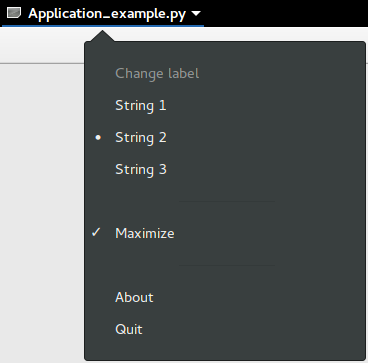24. Application¶
Gtk.Application encompasses many repetitive tasks that a modern
application needs such as handling multiple instances, D-Bus activation,
opening files, command line parsing, startup/shutdown, menu management,
window management, and more.
24.1. Actions¶
Gio.Action is a way to expose any single task your application or widget
does by a name. These actions can be disabled/enabled at runtime and they can
either be activated or have a state changed (if they contain state).
The reason to use actions is to separate out the logic from the UI. For example
this allows using a menubar on OSX and a gear menu on GNOME both simply
referencing the name of an action. The main implementation of this you will
be using is Gio.SimpleAction which will be demonstrated later.
Many classes such as Gio.MenuItem and Gtk.ModelButton support
properties to set an action name.
These actions can be grouped together into a Gio.ActionGroup and
when these groups are added to a widget with Gtk.Widget.insert_action_group()
they will gain a prefix. Such as “win” when added to a Gtk.ApplicationWindow.
You will use the full action name when referencing it such as “app.about” but when
you create the action it will just be “about” until added to the application.
You can also very easily make keybindings for actions by setting the accel
property in the Gio.Menu file or by using Gtk.Application.set_accels_for_action().
24.3. Command Line¶
When creating your application it takes a flag property of Gio.ApplicationFlags.
Using this you can let it handle everything itself or have more custom behavior.
You can use HANDLES_COMMAND_LINE to allow custom behavior in Gio.Application.do_command_line().
In combination with Gio.Application.add_main_option() to add custom options.
Using HANDLES_OPEN will do the work of simply taking file arguments for you and
let you handle it in Gio.Application.do_open().
If your application is already open these will all be sent to the existing instance unless you use NON_UNIQUE to allow multiple instances.
24.4. Example¶

1 2 3 4 5 6 7 8 9 10 11 12 13 14 15 16 17 18 19 20 21 22 23 24 25 26 27 28 29 30 31 32 33 34 35 36 37 38 39 40 41 42 43 44 45 46 47 48 49 50 51 52 53 54 55 56 57 58 59 60 61 62 63 64 65 66 67 68 69 70 71 72 73 74 75 76 77 78 79 80 81 82 83 84 85 86 87 88 89 90 91 92 93 94 95 96 97 98 99 100 101 102 103 104 105 106 107 108 109 110 111 112 113 114 115 116 117 118 119 120 121 122 123 124 125 126 127 128 129 130 131 132 133 134 135 136 137 138 139 140 141 142 143 144 145 146 147 148 149 150 151 152 153 154 155 156 157 158 159 | import sys import gi gi.require_version("Gtk", "3.0") from gi.repository import GLib, Gio, Gtk # This would typically be its own file MENU_XML = """ <?xml version="1.0" encoding="UTF-8"?> <interface> <menu id="app-menu"> <section> <attribute name="label" translatable="yes">Change label</attribute> <item> <attribute name="action">win.change_label</attribute> <attribute name="target">String 1</attribute> <attribute name="label" translatable="yes">String 1</attribute> </item> <item> <attribute name="action">win.change_label</attribute> <attribute name="target">String 2</attribute> <attribute name="label" translatable="yes">String 2</attribute> </item> <item> <attribute name="action">win.change_label</attribute> <attribute name="target">String 3</attribute> <attribute name="label" translatable="yes">String 3</attribute> </item> </section> <section> <item> <attribute name="action">win.maximize</attribute> <attribute name="label" translatable="yes">Maximize</attribute> </item> </section> <section> <item> <attribute name="action">app.about</attribute> <attribute name="label" translatable="yes">_About</attribute> </item> <item> <attribute name="action">app.quit</attribute> <attribute name="label" translatable="yes">_Quit</attribute> <attribute name="accel"><Primary>q</attribute> </item> </section> </menu> </interface> """ class AppWindow(Gtk.ApplicationWindow): def __init__(self, *args, **kwargs): super().__init__(*args, **kwargs) # This will be in the windows group and have the "win" prefix max_action = Gio.SimpleAction.new_stateful( "maximize", None, GLib.Variant.new_boolean(False) ) max_action.connect("change-state", self.on_maximize_toggle) self.add_action(max_action) # Keep it in sync with the actual state self.connect( "notify::is-maximized", lambda obj, pspec: max_action.set_state( GLib.Variant.new_boolean(obj.props.is_maximized) ), ) lbl_variant = GLib.Variant.new_string("String 1") lbl_action = Gio.SimpleAction.new_stateful( "change_label", lbl_variant.get_type(), lbl_variant ) lbl_action.connect("change-state", self.on_change_label_state) self.add_action(lbl_action) self.label = Gtk.Label(label=lbl_variant.get_string(), margin=30) self.add(self.label) self.label.show() def on_change_label_state(self, action, value): action.set_state(value) self.label.set_text(value.get_string()) def on_maximize_toggle(self, action, value): action.set_state(value) if value.get_boolean(): self.maximize() else: self.unmaximize() class Application(Gtk.Application): def __init__(self, *args, **kwargs): super().__init__( *args, application_id="org.example.myapp", flags=Gio.ApplicationFlags.HANDLES_COMMAND_LINE, **kwargs ) self.window = None self.add_main_option( "test", ord("t"), GLib.OptionFlags.NONE, GLib.OptionArg.NONE, "Command line test", None, ) def do_startup(self): Gtk.Application.do_startup(self) action = Gio.SimpleAction.new("about", None) action.connect("activate", self.on_about) self.add_action(action) action = Gio.SimpleAction.new("quit", None) action.connect("activate", self.on_quit) self.add_action(action) builder = Gtk.Builder.new_from_string(MENU_XML, -1) self.set_app_menu(builder.get_object("app-menu")) def do_activate(self): # We only allow a single window and raise any existing ones if not self.window: # Windows are associated with the application # when the last one is closed the application shuts down self.window = AppWindow(application=self, title="Main Window") self.window.present() def do_command_line(self, command_line): options = command_line.get_options_dict() # convert GVariantDict -> GVariant -> dict options = options.end().unpack() if "test" in options: # This is printed on the main instance print("Test argument recieved: %s" % options["test"]) self.activate() return 0 def on_about(self, action, param): about_dialog = Gtk.AboutDialog(transient_for=self.window, modal=True) about_dialog.present() def on_quit(self, action, param): self.quit() if __name__ == "__main__": app = Application() app.run(sys.argv) |